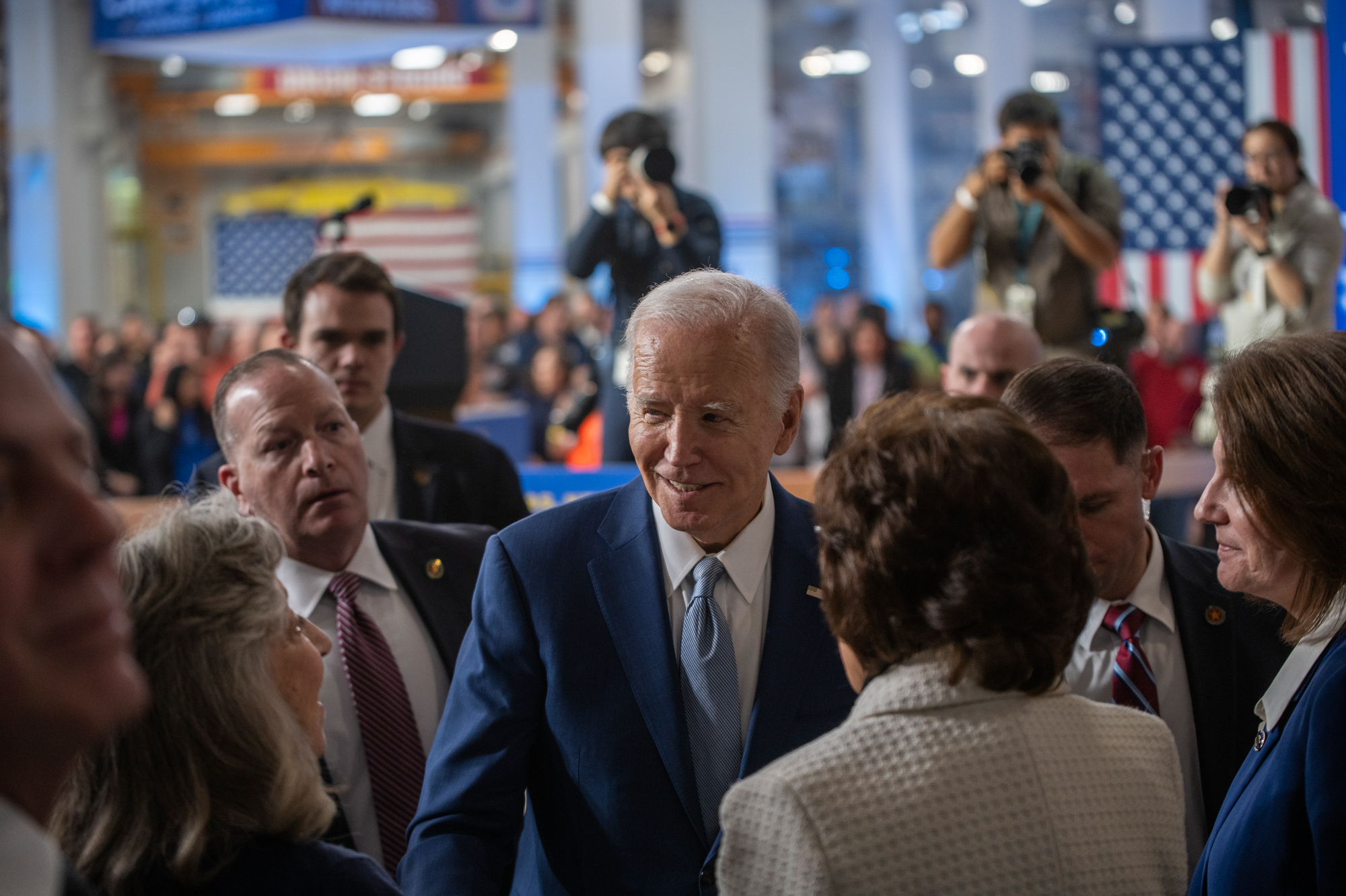Will Nevada elect Rosen and Trump in 2024? Or is recent polling a mirage?

In a May poll of voters in swing states, the New York Times / Siena College had two seemingly contradictory findings for the state of Nevada.
Republican former President Donald Trump led President Joe Biden, a Democrat, by 12 points in a head-to-head matchup. Yet the poll also showed Sen. Jacky Rosen (D-NV) maintained a 2 percentage point lead on her likely Republican challenger Sam Brown.
Such a result would be a 15-point split between the top two races on the ballot — a scenario that has not occurred at such a scale since 2004, when Nevada (then in a much different political culture) re-elected both incumbent president George W. Bush by less than 3 percentage points and Sen. Harry Reid (D-NV) by about 26 points.
The Times’ survey was not an outlier. A poll last week from the Cook Political Report similarly found Trump with a 9-point lead over Biden, but Rosen up 7 points on Brown. Similar divides in polling support between Senate Democratic candidates and Biden are not limited to Nevada, either.
Is such an outcome possible in Nevada? If Nevada voters are truly done with Biden, would that not extend to Rosen, who frequently touts her bipartisanship and works across the aisle but whose major legislative accomplishments are the same as the president?
And if Trump, who has lost Nevada twice, is indeed experiencing a new appreciation among the Silver State’s electorate, why are voters not rewarding Brown, a former Trump campaign volunteer who has invoked the former president repeatedly on the campaign trail, with that same support?
Political experts said that although Nevada has a strong history of ticket-splitting, the nationalization of politics and the fact that there are still five months until the general election make them skeptical that the level of ticket-splitting indicated in these polls will actually occur.
“My guess is … come Election Day, the Senate numbers in Nevada will more closely — they won't be exactly the same — but they’ll more closely match the vote for president in Nevada than what the polls today are saying,” said David Kimball, a political scientist at the University of Missouri – St. Louis who studies ticket-splitting.
Nevada’s ticket-splitting history
Ticket-splitting had been, until fairly recently, a common practice for Nevada voters. According to an analysis by UNLV political scientist David Damore, Nevada elected statewide representatives of different parties — presidential, Senate and gubernatorial races — in 58 percent of elections where a ticket-split was possible between 1950 and 1989.
That increased to 63 percent between 1990 and 2014 — including outcomes such as the 2004 Bush-Reid split and 2012, when President Barack Obama won the state by more than 6 points while then-Sen. Dean Heller (R-NV) eked out a 1-point win.
But split tickets in Nevada have been less common since then. 2016 saw both Democratic presidential nominee Hillary Clinton and Sen. Catherine Cortez Masto (D-NV) win the state by near identical margins of about 2.5 percent.
When Nevada has elected federal representatives of different parties, the Senate candidate has tended to be an incumbent. That was true of Heller in 2012, Reid in 2002 and even dating back to Sen. Howard Cannon (D-NV) in 1976 and Sen. Alan Bible (D-NV) in 1956.
One notable exception was 1988, when Democratic then-Gov. Richard Bryan won his first-ever Senate race, defeating the Republican incumbent Sen. Chic Hecht (R-NV) by 4 percentage points, even as George H.W. Bush won the state by more than 20 points.
Damore said ticket-splitting occurred frequently in Nevada because the state’s political establishment understands that Nevada is small and unlikely to make much of an impact in the House, so the state historically tends to favor seniority over party loyalty in its senators. Nevada senators have had long careers that spanned shifts in the national political winds, from Howard Cannon to Paul Laxalt to Harry Reid.
As Reid in particular accumulated seniority and entered leadership, Damore said he often faced weak challengers (with a notable exception in 1998) who were shut out of the levels of money and support it would take to win by the political class — even in extremely unfavorable national political environments, like in 2010.
The “Republicans for Reid” phenomenon is not totally dead — several prominent Republicans endorsed Cortez Masto in 2022 on the basis that her opponent, Republican former Attorney General Adam Laxalt, was a threat to democracy.
And that attitude can help explain some voters’ reluctance to part with Rosen, an incumbent, even if they indicate (for now) that they will not vote for Biden.
Historically, ticket-splitting is more common between federal and state races, given that governor’s contests often turn on local issues while presidential and Senate races are more indicative of national political environments.
In Nevada, the Democratic nominees for Senate (Rosen) and governor (Steve Sisolak) won in 2018. But 2022 saw the state elect Republican Gov. Joe Lombardo and re-elect Cortez Masto, amid state-specific frustrations about a COVID response tied closely to Sisolak and Lombardo being able to overperform Laxalt in Clark County, having run and won there multiple times before as sheriff.
The split in the last cycle was narrow; Lombardo won by 1.5 percentage points while Cortez Masto won by 0.77. Cortez Masto and Lombardo each received a similar number of votes (498,000 for Cortez Masto, 497,000 for Lombardo) but outpaced their respective counterpart in the other race — Laxalt had about 7,000 fewer votes total than Lombardo, while Sisolak ran behind Cortez Masto by just over 15,000 votes.
It was that small — but critical — number of people who voted for both Lombardo and Cortez Masto that propelled each to victory. And it may have owed in part to the explosion of registered non-partisans in recent years, of whom there are now more of than Democrats or Republicans. Despite most non-partisans leaning towards one party, the increasing popularity of Nevadans identifying themselves as independents may suggest more openness to ticket-splitting.
Nationally, ticket-splitting has declined significantly over the last 40 years, Kimball said. That can be owed to one’s political party becoming a stickier part of their identity as social identity groups have, on the whole, become increasingly aligned with one party or the other. And it also has to do with where the parties now fall on the political spectrum, he said.
“The two parties have moved further apart ideologically — particularly the Republican Party moving to the right,” Kimball said.”So it's easier today for voters to see the policy differences between the parties than it was 30, 40 years ago.”
Explaining recent polls
The polling presupposes two outcomes that experts agreed are highly unlikely: that Rosen could outrun Biden by 15 or more points and that any Nevada candidate could win the state by as large a margin as polls predict.
No president or senator has won the state by more than 7 points since Barack Obama in 2008. And no candidate for any statewide office has won Nevada by more than 5.5 percentage points in a decade.
“I don't think those margins are anywhere accurate,” Damore said. “Because the last time anybody won that big was [Republican Gov. Brian] Sandoval in 2014, versus a nobody.”
The results, then, may have more to do with the notorious difficulty of polling in a state with a highly transient population, many non-English speakers and voters who work atypical hours, Damore said. Be that as it may, Nevada is one of several states experiencing this polling trend — though the difference between Biden and Rosen was larger in Nevada than the other four swing states where Democrats are defending seats, in both the Cook and NYT polls. Cook found Senate Democratic incumbents outrunning Biden by 6 points in Arizona, 11 points in Pennsylvania and 12 points in Wisconsin.
But he said although both candidates in the presidential race are well-known quantities, the relative obscurity of the Senate candidates, and Brown in particular, creates a different dynamic that could be leading to disparate results in polling. Damore expects Rosen to use her financial advantage to, as she already has, to define Brown as an anti-abortion extremist who has flip-flopped on issues such as Yucca Mountain.
“Nobody knows who Sam Brown is yet, so I think she has a little bit of the advantage,” he said.
And he added that he expects some Trump voters to leave the rest of their ballot blank. In 2020, Trump received about 36,000 more votes than House Republican candidates.
Finally, experts speculated that polling is showing such a wide discrepancy because voters may not have tuned into the campaign. With more than five months to go until the election and the Senate primary not yet over, plenty of voters are probably not yet paying attention.
“There likely will be some ticket-splitting — people voting for Trump and Rosen, perhaps,” Kimball said. “But my guess is it's voters that haven't engaged much with the campaign yet.”
